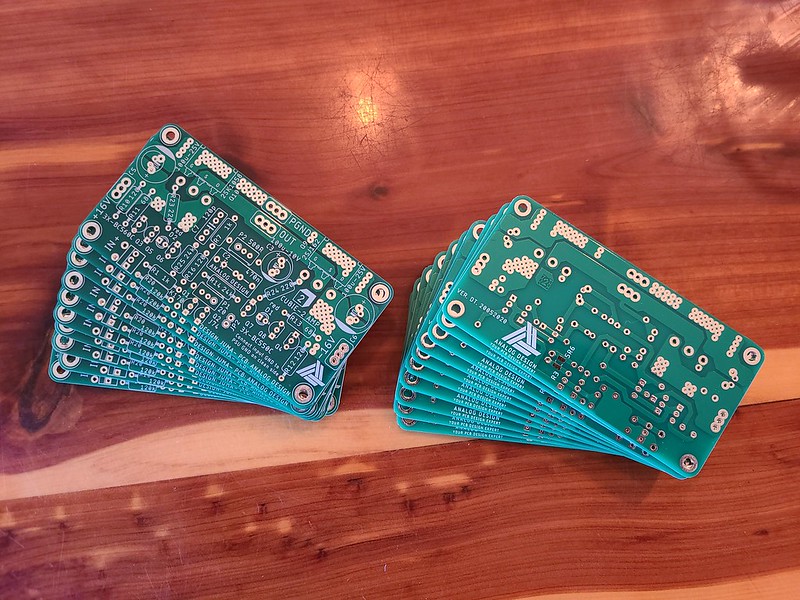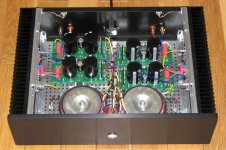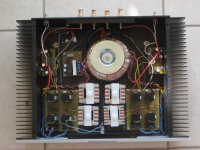KSA992/KSC1845 check pinout!
Thanks. I managed to find some BC560C on eBay. BC550C is still available.
Well done qwertyl 
You got great results with this no-feedback-loop version.
With P1 you can manipulate harmonic profile and then increase/decrease R10 or R12 to null the DC offset at the output. (part labels: Cubie 2 | diyaudio )

You got great results with this no-feedback-loop version.
With P1 you can manipulate harmonic profile and then increase/decrease R10 or R12 to null the DC offset at the output. (part labels: Cubie 2 | diyaudio )
An update on my Cubie2.
After listening to the original (no feedback) version, a friend o mine, whose opinion I highly respect, suggested eliminating the capacitance multiplier stage and replacing it with a simple CLC filter. That idea was appealing to me.
So, just for a starting point, and to make things simpler, I decided to replace the MOSFET circuit with a power resistor of 2.2 Ohms, just on one channel, and make a direct A-B comparison. Well, I must say that the difference was huge! It was one of the rare occasions where I felt that a veil was removed from the scene. Suddenly, the soundstage was wider and deeper and the instruments were precisely put in the musical scene.
So, it was decided: the cap multipliers should go. In a second stage, I was inrigued to try the CLC filter against the CRC. For that, I wound two coils on EI75 bobbins, using 0.8 mm magnet wire and filling out the whole height of the bobbin (and a little more, since I wasn't going to use any lamination). This way, I produced two air-core coils with a resultant inductance of ca. 8 mH. I replaced two of the power resistors with these coils and made again an A-B listening test. The difference was not that huge as it was with moving from cap multipier to CRC filter, but, clearly, there was a difference: the sound was a little more defined with more air. Finally, I wound two more coils (my PS is dual mono) and, now, I must confess that my Cubie2 sounds absolutely fantastic!
Here you can see a picture of the final configuration.
So, Juma, thank you again for such a marvelous amplifier and for your help so far.
Greetings,
Evangelos
After listening to the original (no feedback) version, a friend o mine, whose opinion I highly respect, suggested eliminating the capacitance multiplier stage and replacing it with a simple CLC filter. That idea was appealing to me.
So, just for a starting point, and to make things simpler, I decided to replace the MOSFET circuit with a power resistor of 2.2 Ohms, just on one channel, and make a direct A-B comparison. Well, I must say that the difference was huge! It was one of the rare occasions where I felt that a veil was removed from the scene. Suddenly, the soundstage was wider and deeper and the instruments were precisely put in the musical scene.
So, it was decided: the cap multipliers should go. In a second stage, I was inrigued to try the CLC filter against the CRC. For that, I wound two coils on EI75 bobbins, using 0.8 mm magnet wire and filling out the whole height of the bobbin (and a little more, since I wasn't going to use any lamination). This way, I produced two air-core coils with a resultant inductance of ca. 8 mH. I replaced two of the power resistors with these coils and made again an A-B listening test. The difference was not that huge as it was with moving from cap multipier to CRC filter, but, clearly, there was a difference: the sound was a little more defined with more air. Finally, I wound two more coils (my PS is dual mono) and, now, I must confess that my Cubie2 sounds absolutely fantastic!
Here you can see a picture of the final configuration.
So, Juma, thank you again for such a marvelous amplifier and for your help so far.
Greetings,
Evangelos
Attachments
Thanks for your kind words juma
I will report back after my listening tests this evening...
Very nice work qwertyl!! Well laid out boards and short low wiring.
Have you experimented with harmonics using P1 or are the THD plots you show with P1 pretty much in the center position minimizing DC offset.?
nash
Very nice work qwertyl!! Well laid out boards and short low wiring.
Have you experimented with harmonics using P1 or are the THD plots you show with P1 pretty much in the center position minimizing DC offset.?
nash
Thanks nash.
No, I haven't experimented with harmonics. FFT picture was taken at about 7W with P1 set to a value that nulls DC offset at the output.
The difference was not that huge as it was with moving from cap multipier to CRC filter, but, clearly, there was a difference: the sound was a little more defined with more air.
My conclusions after similar comparisons are different: the coils improve bass and separation and fill up the vocals towards the lower midrange but make a dog's breakfast out of the highs. Whether the overall effect is positive is very system-specific.
In any case, thanks for sharing. It is refreshing to know some people here actually do listening tests and are not satisfied with just stuffing boards.
Last edited:
My initial impressions after listening to Cubie 2 for a couple of evenings - this is an excellent sounding little amp! 🙂
Last 2 years or so I was using almost exclusively my M2 clone, so it is easy for me to compare Cubie 2 to M2. Immediately after switching to Cubie 2 I noticed that it has higher gain than M2 (I had to turn volume pot down) and as expected Cubie 2 has less control in bass, which is quite good for my speakers. Cubie 2 is dead quiet, I never managed to completely remove a bit of buzzing (ear inch from the speaker) from my M2. In my opinion M2 sounds warmer and more "in your face", Cubie 2 is a bit drier, thinner, but also slightly more precise. Both are great amps, best I have built so far!
Last 2 years or so I was using almost exclusively my M2 clone, so it is easy for me to compare Cubie 2 to M2. Immediately after switching to Cubie 2 I noticed that it has higher gain than M2 (I had to turn volume pot down) and as expected Cubie 2 has less control in bass, which is quite good for my speakers. Cubie 2 is dead quiet, I never managed to completely remove a bit of buzzing (ear inch from the speaker) from my M2. In my opinion M2 sounds warmer and more "in your face", Cubie 2 is a bit drier, thinner, but also slightly more precise. Both are great amps, best I have built so far!
Thanks for sharing.
Qwertyl and kenev, what preamp, if any, are you using before the Cubie 2 in your comparisons?
Qwertyl where did you get those very nice PCB's from?
Thanks.
nash
Qwertyl and kenev, what preamp, if any, are you using before the Cubie 2 in your comparisons?
Qwertyl where did you get those very nice PCB's from?
Thanks.
nash
Thanks for sharing.
Qwertyl and kenev, what preamp, if any, are you using before the Cubie 2 in your comparisons?
Qwertyl where did you get those very nice PCB's from?
Thanks.
nash
Just 25k stepped attenuator in front of Cubie 2.
I was lucky to get a couple of spare boards from diyaudio forum member...
Hi Nash,
For a preamplifier, I use a tube one, namely Allen Wright's FVP5. In my opinion, it is a great sounding preamp.
For a preamplifier, I use a tube one, namely Allen Wright's FVP5. In my opinion, it is a great sounding preamp.
Thanks for sharing.
Qwertyl and kenev, what preamp, if any, are you using before the Cubie 2 in your comparisons?
Qwertyl where did you get those very nice PCB's from?
Thanks.
nash
Hi,
That is indeed an excellent tube preamp. A few years back I missed a chance to buy a RTP3D.
In post 265 you mention substituting a 2.2r resistor instead of the Mosfet. Did you also short R6 as shown in the CM schematic?
Were you running 15vAC transformers with 16vDC output before? Wondering why you chose a relatively high value 2.2r instead of say 0.1r?
Thanks.
nash
That is indeed an excellent tube preamp. A few years back I missed a chance to buy a RTP3D.
In post 265 you mention substituting a 2.2r resistor instead of the Mosfet. Did you also short R6 as shown in the CM schematic?
Were you running 15vAC transformers with 16vDC output before? Wondering why you chose a relatively high value 2.2r instead of say 0.1r?
Thanks.
nash
Hi,
That is indeed an excellent tube preamp. A few years back I missed a chance to buy a RTP3D.
In post 265 you mention substituting a 2.2r resistor instead of the Mosfet. Did you also short R6 as shown in the CM schematic?
Were you running 15vAC transformers with 16vDC output before? Wondering why you chose a relatively high value 2.2r instead of say 0.1r?
Thanks.
nash
Hi nash,
In fact, I'm also building an RT3C preamp, but I have left it unfinished for quite a while now.
Well, the purpose of the 2,2R resistors was to bring the output voltage approximately to the same level as the Cx circuit. Since the MOSFET drops about 4V and each rail of the amp draws ca. 0.9A, putting a 2.2R resistor in each rail I have a voltage drop of ca. 2 volts. This is a little higher than the Cx, but, if I was to drop 4 volts, I had to use 4.7R resistors, although with much higher power dissipation. Anyway, these were used just to make a direct comparison. The resistors were replaced by ca. 8 mH chokes.
I don't know which is the R6 resistor you are referred to. To be clear, I have left the whole MOSFET network out. Namely, my PS is a following: bridge, cap, choke, cap.
My transformer's secondary is 16 volts. With the Cx in, PS voltage was 16.5 volts. With the CLC filter, it is now ca. 18 volts.
Regards,
Evangelos
Folks, yoaudio here,
Have you ever wanted to make your own cubie2 amplifier, but didn't want to etch your own PCB boards?
Well now you can with this amazing offer!!!
Introducing "the cubie2 pcb boards" (jfet version - without the feedback loop ).

Layout and design by two of diyAudio's finest designers,
juma for the schematic and prasi of "analog design" for the pcb.
This is one of the most amazing amplifiers of our time,
but don't take our word for it.
Hear what others are saying about this most amazing amplifier.
There you have if Folks, one of the most amazing amplifiers of our time!
"How can I get one of these great PCB boards"?
I'm glad you asked that.
It's simple, if you want a board, make at least a $10.00 donation to diyAudio,
forward me the receipt. I would send you one board free of charge in a plain envelope with no tracking/ customs forms.
I sent out boards like that before with no problems.
These are the exact same boards I send diyAudio member "qwertyl".
And if you act NOW, I will double the offer, and you
need not to pay separate shipping and handling charges.
So there you have it, 2 PCB boards, enough for a stereo amplifier, for a USD 10.00 dollar or more donation to this great forum that just turned 20 years old.
I only have 10 sets to give away,
make a list below, the first 10 to sign up gets the boards!!
These are sure to go fast!
Limit 1 set per member.
Best Regards
yoaudio
Have you ever wanted to make your own cubie2 amplifier, but didn't want to etch your own PCB boards?
Well now you can with this amazing offer!!!
Introducing "the cubie2 pcb boards" (jfet version - without the feedback loop ).

Layout and design by two of diyAudio's finest designers,
juma for the schematic and prasi of "analog design" for the pcb.
This is one of the most amazing amplifiers of our time,
but don't take our word for it.
Hear what others are saying about this most amazing amplifier.
Build with the components I had for other projects that never saw daylight... It really rocks with my 94dB Cabasse speakers! 🙂
Juma, thanks a lot for such an incredible design,
All the best,
Berny
We compared it to a class A/B amplifier and the Cubie2 sounded much better to us.
We just did another listening session, this time also to compare the Cubie2 with the F5.
In short: choose the Cubie2 to build 🙂
First we listened with some test tracks to the Cubie2, everything sounded very good: holographic, detailed, very good bass, everything sounded correct, it started us foot tapping 🙂
After the Cubie2 the same test tracks with the F5 and immediately we heard that the bass/lower end was lacking/slow, it sounded like there was something missing, it was less involving.
Cubie2 is a very good amplifier, one to keep.
@Juma:
Congratulations with such a great design !
Regards,
Danny
I've been listening to Cubie 2 for a couple of weeks. Today I replaced it with my F5, and found I suffered from Cubie 2 withdrawal. It is a great amplifier. Cubie 2 is dynamic and full, punchy. Thanks, everyone!
My Cubie 2 is better than my F5. Is any Cubie 2 better than any F5? I don't know.
The F5 is a darn fine amp. The Cubie 2 is three-dimensional with an uncanny way of presenting music so one can listen into the mix, with drums sounding like drums and lyrics more easily understood. It's fun to listen to music with it. It is so simple and affordable, if you can find the jfets and the latfets, there is no reason not to build one!
Irritating. Just finished my F4 with a SET Flea Powered Tube front end. Cubie 2 is better. My run at the absolute sound is thwarted by Cubie 2. Damn you, juma. 🙂
At least I own Cubie 2. Nobody is going to run off home with it. It is s-o-o-o-o right. Everything else is slightly compromised. Thanks, juma!!!!!
I'm completely surprised from the final result. The sound is amazingly fantastic: extremely analytical without being clinical, voices are natural and warm without any sign of sibilance, instruments separation is exemplary, while bass is deep and firm. In all, I'm deeply satisfied from my new amp and I'm seeking for free time to sit down and enjoy it.
My initial impressions after listening to Cubie 2 for a couple of evenings - this is an excellent sounding little amp! 🙂
Last 2 years or so I was using almost exclusively my M2 clone, so it is easy for me to compare Cubie 2 to M2. Immediately after switching to Cubie 2 I noticed that it has higher gain than M2 (I had to turn volume pot down) and as expected Cubie 2 has less control in bass, which is quite good for my speakers. Cubie 2 is dead quiet, I never managed to completely remove a bit of buzzing (ear inch from the speaker) from my M2. In my opinion M2 sounds warmer and more "in your face", Cubie 2 is a bit drier, thinner, but also slightly more precise. Both are great amps, best I have built so far!
There you have if Folks, one of the most amazing amplifiers of our time!
"How can I get one of these great PCB boards"?
I'm glad you asked that.
It's simple, if you want a board, make at least a $10.00 donation to diyAudio,
forward me the receipt. I would send you one board free of charge in a plain envelope with no tracking/ customs forms.
I sent out boards like that before with no problems.
These are the exact same boards I send diyAudio member "qwertyl".
And if you act NOW, I will double the offer, and you
need not to pay separate shipping and handling charges.
So there you have it, 2 PCB boards, enough for a stereo amplifier, for a USD 10.00 dollar or more donation to this great forum that just turned 20 years old.
I only have 10 sets to give away,
make a list below, the first 10 to sign up gets the boards!!
These are sure to go fast!
Limit 1 set per member.
Best Regards
yoaudio
- Home
- Amplifiers
- Pass Labs
- Cubie2


